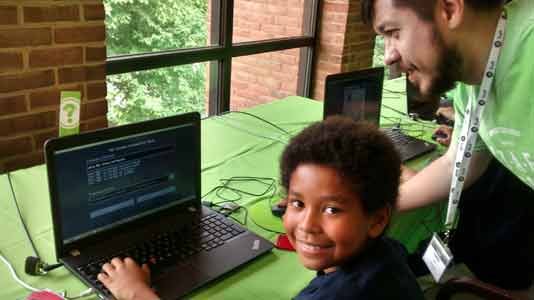BALTIMORE — Technology has significantly changed the way people, businesses and institutions interact at a record-breaking pace. Thanks to iDTech Camp, students ages seven to 17 are educated and trained in small class sizes to gain the skills they need to thrive in a tech-driven world.
Businesses understand the importance of having a solid foundation in STEM (science, technology, education, and math) education. STEM disciplines engage students in vital 21st century skills centered on problem-solving, creativity, teamwork, critical thinking and effectively communicating ideas. The iD Tech summer camp hosted 52 students at a local university to engage in hands-on computer coding, App development, game designing, 3D modeling, robotics, digital photography, web design and filmmaking.
Andrew Pham who served as the camp director for four years says his role is to ensure the children’s safety, maintain order and guide the instructors so that they can maximize their time in assisting campers with their daily designing projects. Camp instructors work in the fields they are teaching at the camp. The instructors include a professional biostatistician and video game programmers. Working with a maximum of eight students, camp instructors provide campers with the direction they need to complete their tech projects. Even with its successes, iD Tech has its challenges too. Many of its instructors are eventually recruited by big tech corporations like Google and Microsoft which leaves the organization in a constant mode of hiring qualified camp alumni.
Eleven-year old Ali Brooks attended the camp for the first time this summer. By the fourth day, he had created nine games from newly learned skills using Scratch. Scratch is a programming language where one can design a myriad of video games. Ali designed an age computation, as well as paintball and basketball-themed video games, just to name a few. “What is really exciting about the camp is finishing a big project after working on it for two days,” said Ali. He contributes his success at camp to his classes during the school year where he excels at mathematics and technology education. “I like Scratch because it’s easy for anyone to pick up and learn,” said Ali.
Milo Kiddugavu, 11, wrote coding for Minecraft. He designed, “a creepy apartment building with creepers inside.” The creepers include skeletons, zombies, spawn skeletons and spawn mooshroom- a red and white cow with mushrooms on its back. He also wrote coding commands to teleport his game character from one area to another space in the game. The aspiring game coder input data so that the player will receive an “achievement” which consisted of a new weapon to use during battles and food items to help restore the life of the character.
Milo takes his education and the industry seriously and studies programming an hour each day and watches tutorial videos online. Milo began studying a year ago and aspires to continue when he goes to college. He contributes math to his success in coding and uses division to help him figure out the center of an area during the process. “I love Apple computers but I choose Microsoft for designing, gaming and coding. Macs don’t have the proximity for that,” he said. In his second week of camp, he said he learned a lot about Minecraft, designing new games and meeting new friends.
The campers also gained access to cutting-edge 3D print technology which uses Cura software. The printer has the capability of producing prototypes for game pieces and designing buildings. With variations of the 3D printer, it can develop prototypes using concrete, steel, metal and even gold. Pham, who teaches at Baltimore City Public Schools and at a local university said, “This is what can happen when you have resources.”
Students who study STEM disciplines can position themselves to be highly marketable and be head-and-shoulders above their non-STEM counterparts. There is still plenty of room for more students to embrace STEM. According to data from Burning Glass Technologies, in 2013 there were 5.7 million openings in STEM fields. The data also indicated that 4.4 million openings required at least a bachelor’s degree and 2.3 million of which were entry-level jobs that call for less than two years of experience.
